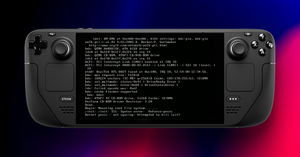You could follow my guides to install hacks and tweaks by the letter and still be unhappy with the result. Be it because you didn’t like what a tweak did to your Deck, or were unlucky and had something go wrong. (Or because you installed Windows and are not regretting it.)
Thankfully restoring steamOS and resetting the Steam Deck is not too much of a hassle. Of course, this guide is also for you if you decide to upgrade your SSD.
Before you start the recovery process, you need a few things: a USB key with a minimum of 8 GB (preferably one with USB-C and USB-A like this one) and a USB-C dock if you have USB-A thumb drives (this is the one I successfully used with the Deck).
Now to the guide:
- Download the recovery image from this link (it starts the download immediately).
- Prepare the USB key. Depending on the OS, follow one of the guides below:
- Windows: Download and run Rufus. Select the recovery file, and write it to your drive. You don’t need to change any of the settings. Keep in mind that Rufus will format the thumb drive, however.
- macOS: Download and run Balena Etcher. Select the recovery file, and write it to your drive. Keep in mind that Etcher will format the thumb drive, however.
- Linux: On Linux, you can either also use Balena Etcher. Select the recovery file, and write it to your drive. Keep in mind that Etcher will format the thumb drive, however.
- Plug your thumb drive into your Steam Deck.
- Shut down your Steam Deck. Click the
Steam button, go down toPower, and thenShutdown. If it’s frozen, hold thePower buttonuntil the Deck is off. - With the Deck turned off, hold down the
Volume Down buttonand click thePower button. When you hear the chime, let go of theVolume Down button. - You’re now in the
Boot manager. Here, chooseEFI USB Device. - The Steam Deck will boot into a desktop environment — this can take up to a minute. You can navigate here using the trackpads and the R2-trigger.
- You have several options now, depending on what you want to do:
Re-image Steam Deck: This is equivalent to a factory reset. All, and I repeat all data, will be wiped and replaced with stock SteamOS. Again, all data will be wiped! This is the one you want to use when replacing SSDs.Clear local user data: This option removes all your user data, be it games, system configurations or personal content. SteamOS won’t be touched, but your files are gone regardless.Reinstall Steam OS: This will reinstall SteamOS without touching your games or personal content. However, it’s not always a given that your personal data remains, it might get lost regardless.Recovery tools: The recovery tools allow you to make changes to the Steam Deck boot partition.
That’s it. If you followed this guide, and depending on the option you chose in step 8, your Steam Deck should be fully functional again.




